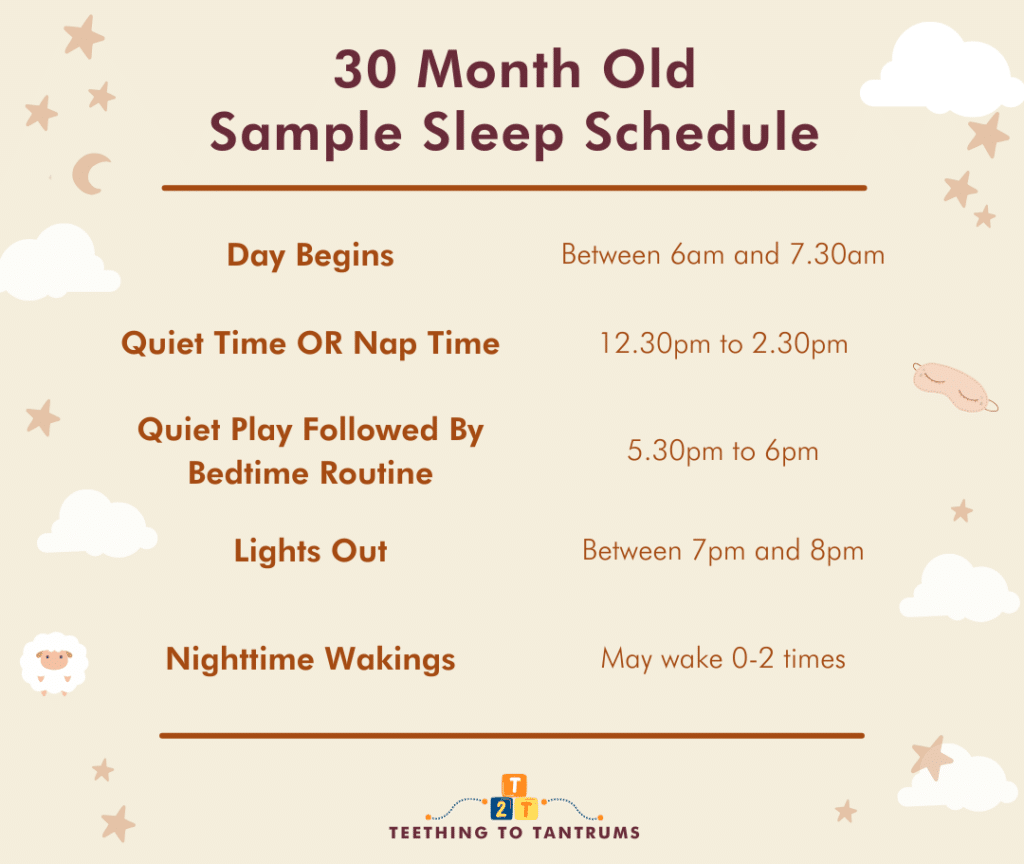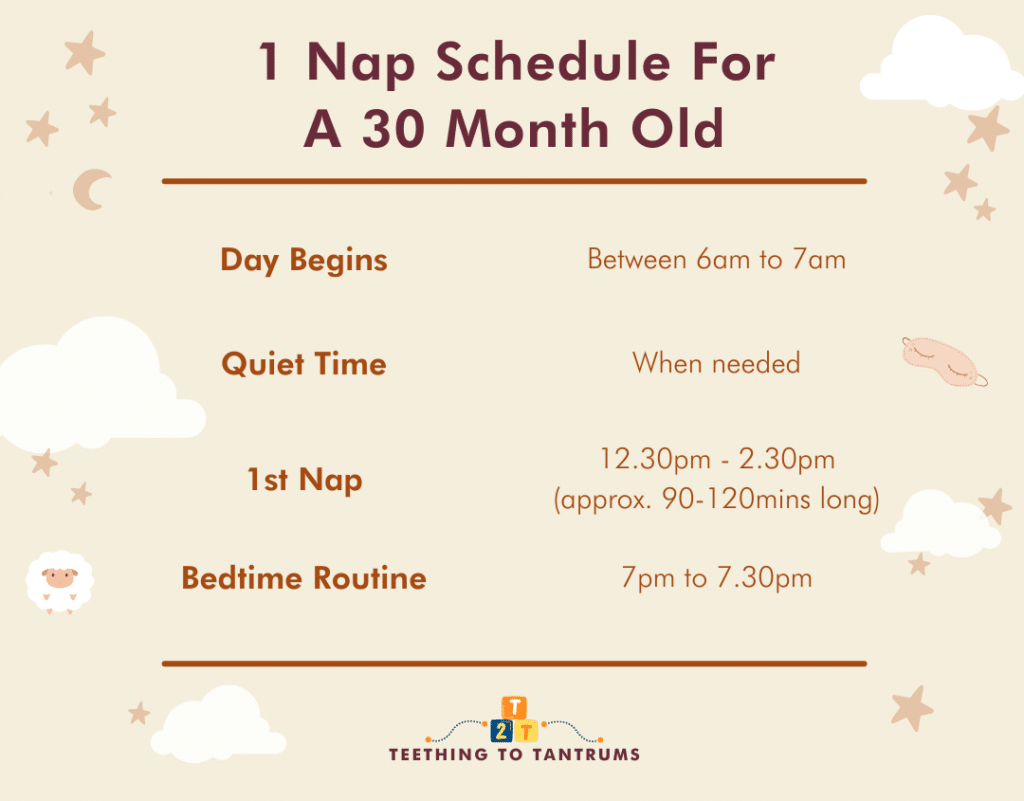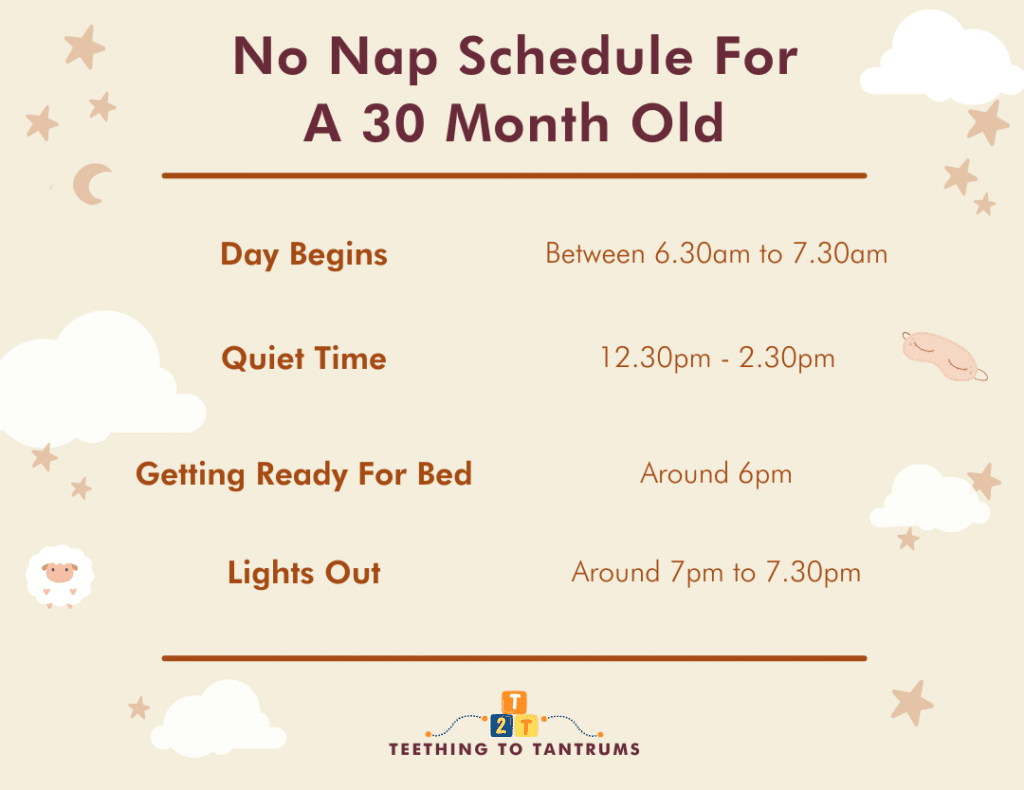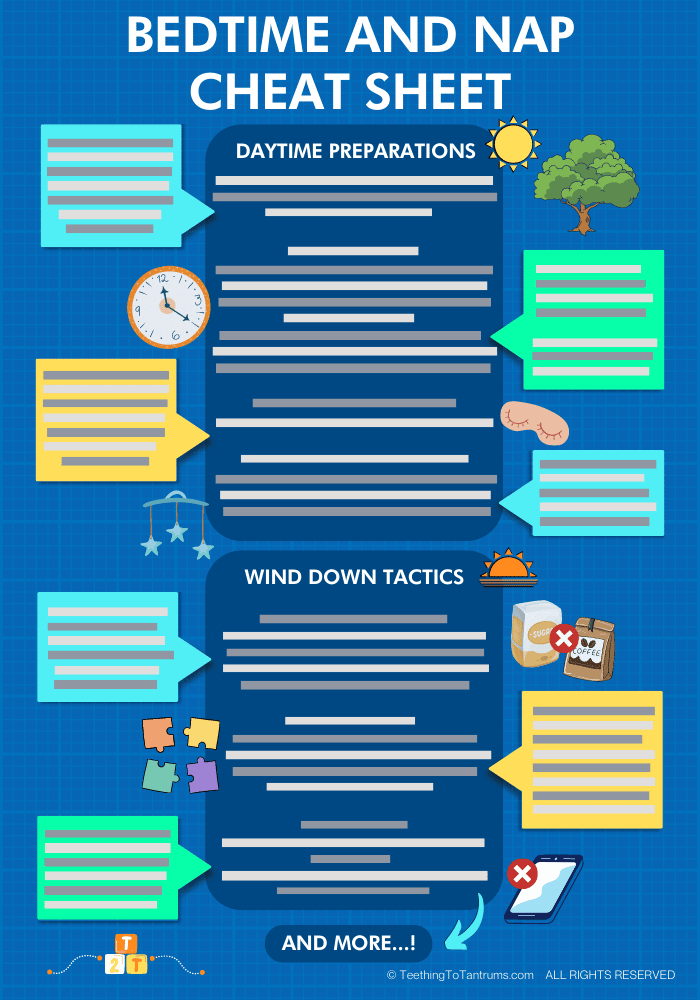We all know how important sleep is for young children and as they grow, it can be a challenge to make sure they get the sleep they need.
But healthy sleep patterns start with a schedule. So, here’s how to get your little one onto a regular 30-month-old sleep schedule with top tricks to make maintaining it as easy as possible.

Table of Contents
How Much Should A 2.5-Year-Old Sleep?
At 2.5 years old, your child needs between 11 to 14 hours of sleep in 24 hours. This includes nighttime sleep and a daytime nap or quiet time for about 2 hours.
Sample 30-Month-Old Sleep Schedule
By 2.5 years old, your little one will easily be sleeping through the night and will have transitioned down to 1 nap in the afternoon on most days.
Here is a sample 30-month-old sleep schedule to give you a guideline for how your little one’s day can flow:

REMEMBER: This sleep schedule is only a guideline and will differ from child to child. The most important thing to focus on is how much sleep your child is getting in 24 hours.
30-Month-Old Nap Schedule
At 30 months old, your child is likely transitioning from two naps a day to one nap a day. During a nap transition, flexibility is key.
Some days your little one may need to nap and on others, they may not. They may also need a quick cat nap in the late morning or afternoon to get through the day.
Don’t be afraid to wake your little one from a cat nap (they should not be more than 30 minutes long) to ensure your toddler is ready to sleep when bedtime comes around.
TOP TIP: If your toddler is resisting daytime sleep, I always advocate a quiet time after lunch instead. Sometimes they may even surprise you and fall asleep but if not, quiet time is an ideal way to allow your little one to recharge their batteries and help avoid overtiredness.
Sample Nap Schedule
Here is a sample nap schedule for a 30-month-old with 1 daytime nap:

Here is a sample nap schedule for a 30-month-old with no daytime naps:

Again, please note that this is a sample nap schedule for a 30 month old and your child’s sleep needs may vary from those of your friends and family’s children.
How Long Should A 2.5-Year-Old Nap For?
Most 2.5-year-olds will take naps between 1 and 2 hours long. However, as your child gets closer to 3 years of age, they will be able to stay awake for longer periods, which means that it’s easier for them to shorten, resist, or skip naps.
How Many Naps Should A 2.5-Year-Old Take?
Most 2.5-year-olds require one nap that lasts for 1-2 hours after lunch. As they approach 3 years of age, they may be able to get through the day without napping at all on some days and some 3-year-olds may stop napping altogether.
As a rule of thumb if you aim for 6 hours of wake time before naptime your little one is more likely to be ready for sleep.
If your child is showing signs of being tired, such as rubbing their eyes or becoming cranky, it may be time for a nap. It is better to err on the side of caution and allow your child to nap if they need it, rather than forcing them to stay awake to fit the schedule and ultimately becoming overtired.
TOP TIP: If your little one is not napping during the day you will need to bring bedtime forward to ensure they are getting the sleep they need.
2.5-Year-Old Bedtime Routine
I am always emphasizing how important a regular and healthy bedtime routine is essential for your child’s sleep. An established and consistent bedtime routine has been proven to improve sleep and reduce nighttime wakings.
For a 2.5-year-old sleep schedule, your little one’s bedtime routine should consist of:
- Having a calm dinner time,
- Then a quiet playtime free of screens
- Followed by a warm and calm bath,
- Cozying up together with a suitable book,
- Having a drink and toilet visit
- Finally, settling down to sleep in their crib/bed in a dimly lit room.
The entire bedtime routine should start between 6 pm and 6.30 pm and ideally, take no longer than 60 minutes.
REMEMBER: The bedtime routine should follow the same steps and be repeated at the same time every evening to ensure your 2.5-year-old can recognize the signs that bedtime is coming to help them settle and fall asleep more easily. You can use a bedtime routine chart to help your little one know what’s coming up too! And a toddler alarm clock can help with nighttime and early morning wakings.
What Time Should a 30-Month-Old Go To Bed?
I generally recommend that 2.5-year-olds go to bed between 7:00 PM and 8:00 PM. However, this can vary based on the child’s daily routine, wake-up time, and individual sleep needs.
If your child skips a nap, offer an earlier bedtime to help limit overtiredness and lengthen nighttime sleep. If they fall asleep late in the day (nod off in the car, for example)… then push bedtime out a bit.
While it depends on the individual child and their sleep routine, anything later than 8.30pm would be considered late for a toddler’s bedtime.
Looking to get your little one to sleep quickly and effortlessly? Check out my Bedtime and Nap Cheat Sheet and master the art of making daytime naps and bedtimes as seamless as possible.
A bedtime & nap cheat sheet so good your little one will ask you to put them to bed...
Laura Williams "This is a life saver! I'm so glad I downloaded your bedtime & nap cheat sheet. My little one actually asked me to put him to bed last night! Unbelievable! Thank you so much!"
Click Here For The FREE Cheat Sheet
Is There A Sleep Regression At 30 Months?
Yes and no…
Sleep regressions are possible at any age and can be triggered by all sorts of developmental and environmental occurrences.
Whilst sleep regressions are more common at 4 months, 6 months, between 8 and 10 months, 12 months old, and around 18 months old…
Your 2.5-year-old can still experience a sleep regression especially if there has been a big change in their life such as the arrival of a sibling or if they have started nursery school.
This is because all that new activity can disrupt their sleep patterns until they settle into their new routine.
So if your 30-month-old’s sleep schedule is disrupted with your child fighting sleep, increased nighttime wakings and restlessness then they are very likely experiencing a short-term sleep regression.
Read this post to help you navigate this situation: Sleep Regression: What, Why, Signs & Sanity-Saving Solutions.
30-Month-Old Sleep Schedule Tips
Establishing and maintaining a 30-month-old sleep schedule will make your day much easier to manage because after all… Everything starts and ends with sleep!
Here are some tips to help you create a successful sleep schedule for your little one.
- Get out into the fresh air: This is very important. Encouraging outdoor playtime during the day will help your child expend energy, get fresh air, and balance their melatonin levels and circadian rhythm.
- Lower the energy at the end of the day. Prepare your toddler for sleep by not letting things get too exciting before bedtime. Keep your interactions calm and low-key with calm activities after teatime.
- Use quiet time: When going through a nap transition, you can use quiet time to give your child a break instead of getting them to take a nap. This will prevent overtiredness at the end of the day and will encourage self-settling too.
These classic 24-piece wooden puzzles are easy to grasp, lift and fit together to create bright scenes of the ocean, being on safari and walking among dinosaurs! Perfect for a quiet afternoon toddler activity, these puzzles will be a wonderful addition to any toy box.
- Offer something to play with when your little one wakes early. If your little one is waking early and does not want to go back to sleep keep some toys and books for toddlers nearby that you can give them to play with while you return to bed for a while. This is a great habit to get into and encourages your little ones to play independently when they wake up as they grow.
- Teach your toddler to self-settle: Encourage your child to self-settle by putting them to bed while they are still awake, so they learn to fall asleep on their own. You may need to implement some sleep training if your little one is struggling to settle without you.
- Work with your toddler’s growing independence: Toddlers love to make their own decisions. So to help you avoid bedtime tantrums, accommodate their developing independence by offering two acceptable choices such as which pajamas to wear or which stuffed animal to sleep with.
- Offer a bedtime snack: A small bedtime snack can help your child feel full and comfortable before bed. This along with a drink can also avoid delay tactics later on. I find a milky drink and a banana are good evening snacks.
- Introduce a night light. Introducing a night light can help alleviate separation anxiety and fear of the dark and help your little one self-settle. Some white noise machines come with built-in night lights but there are some lovely toddler night lights out there that can also project onto the ceiling like this one:
Finding the right night light for your child can be quite a task. You want something safe, comforting, and practical. The Cozy Starry Night Light ticks these boxes, with eye-friendly warm lighting and an easy-to-use dimmer.
Its gentle glow makes it the best night light for feeding baby, diaper changes, or comforting your little one back to sleep.
As your baby grows the Cozy Starry Night Light's starry sky projection can provide comfort and gentle quiet time stimulation. Its soft lighting ensures a dreamy, peaceful environment, supporting your baby’s natural sleep cycle.
It really is a fantastic nightlight (at a very reasonable price!)
- Eye-friendly warm lighting with adjustable brightness.
- Includes a timer function for convenience.
- Projects a starry sky that is soothing for little ones.
- Rechargeable battery, so it's very portable.
- A USB adapter is not included for charging.
- The star projector is static without motion (however, this is ideal for very young babies and toddlers).
- Battery life varies based on the brightness settings.
- No screens AT LEAST 1 hour before bed. At this age, you may be tempted to let your little one play with a screen device. My advice would be to not let this happen at such a young age… But if you do decide for your little one to have screen time they should not be on it at least 1 hour before bed as the blue light emitted from screens is proven to disrupt your child’s ability to sleep. Complete simple games with wooden toys or read books together instead.
- Handle bed transitions carefully: If transitioning from a crib to a toddler bed, make sure your child is comfortable and safe in their new sleeping space. If your toddler is refusing to sleep in their new bed, try letting them take naps in their new bed before making the full transition.
- Use audiobooks: I have always found that audiobooks are brilliant for settling toddlers for bedtime and nap time as well as having the added advantage of developing your little one’s imagination and vocabulary. My son loved falling asleep to them and I always used them for long-distance travel too. There are plenty of apps and online resources to choose from but if you have Audible, here is one of my favorites to get you started.
Common 30-Month-Old Sleep Problems
Sleep problems can occur at any age. Here are some of the most common sleep problems for this age group and how to handle them.
- Nighttime Wakings. If your child wakes up during the night, try not to rush in immediately. Give them a chance to settle themselves back to sleep. If they continue to cry, go in and reassure them with minimal talking or drama. If they get out of bed, resist letting them into your bed. Return your toddler to their own bed and resettle them. Using a night light and or toddler alarm clock can help too.
- Bedtime Battles. If your child resists going to bed, ensure your little one has a recognizable and consistent bedtime routine. This should include a bath, storytime, and a lullaby. Stick to the routine every night to help your child associate these activities with sleep and avoid screens in the lead-up to bedtime. Also, stay one step ahead of any delaying tactics by offering a snack and drink of water and making sure your little one has visited the bathroom before they settle.
- Separation Anxiety. If your child is afraid to be alone at night, try using a nightlight, an audio app, and a favorite stuffed animal to provide comfort. You can also try the gradual retreat sleep training method. Encouraging your little one to play safely alone during the day can also help with separation anxiety as can encouraging them to spend time away from you with friends and family during the day.
- Tantrums. If your child throws a tantrum at bedtime, remain calm and consistent. Try not to give in to their delaying tactics, as this can reinforce the behavior. Check your little one is not getting over tired as tantrums are more likely to happen if they are. If necessary adjust bedtime and or nap times.
- Sleep Regression. Sleep regression is in essence a temporary disruption in sleep patterns. It can occur at various stages of development for various reasons, including at 30 months. If your child experiences sleep regression, try and identify the trigger and maintain a consistent bedtime routine. Offer an earlier bedtime to help limit overtiredness if your little one is not sleeping well during the day.
- Early Morning Waking. If your child wakes up early, try using black-out blinds and a toddler alarm clock, like this one, that indicates to your toddler when it’s time to get up. You can also try adjusting their bedtime to encourage them to sleep longer.
- Nightmares and Night Terrors. If your child has a nightmare, comfort them and reassure them that everything is okay. If they have a night terror, wait it out and do not try to wake them. Night terrors usually pass on their own.
- Moving from crib to bed: The move to a big bed can easily disrupt your toddler’s sleep routine. Manage the transition slowly and carefully ensuring your little one is involved in the process. If they repeatedly get out of bed be firm and consistent in your response by taking them back to their bed. This may take several nights so you will need to be patient. Using a reward chart can work really well to offer an incentive for your toddler to stay in bed.
Motivate your little ones with this fantastic magnetic reward chart. This colorful and vibrant chart features adorable safari animals and comes with 18 different chore magnets so you can personalize it to your routines. Fully interactive and adaptable, your bedtimes will never stall again!
Frequently Asked Questions About 30-Month-Old Sleep Schedules
Looking for more information about 30-month-old sleep schedules? Find answers to the most common questions here.
Q: What time should a 30-month-old go to bed?
A: A 30-month-old should go to bed between 7:00 PM and 8:00 PM. It is important to establish a consistent and recognizable bedtime routine to help your child feel ready for sleep.
Q: Is there a sleep regression at 30 months?
A: Yes, there can be a sleep regression at 30 months. Sleep regressions can occur at any age. During this time, your child may experience disruptions in their sleep patterns and may have trouble falling asleep or staying asleep. Moving from a crib to a bed or nap transitions can trigger a sleep regression. It is important to maintain a consistent sleep schedule to help your child through this phase.
Q: What are some tips for establishing a 30-month-old’s sleep schedule?
A: Some tips for establishing a 30-month-old’s sleep schedule include creating a consistent bedtime routine, setting a regular bedtime and wake-up time, and limiting screen time before bed. It is also important to ensure that your child is getting enough physical activity during the day and having a regular daytime nap or quiet time.
Q: What time should a 30-month-old wake up?
A: 30-month-old should wake up between 6:00 AM and 8:00 AM. It is important to establish a consistent wake-up time to help your child’s body adjust to a regular sleep schedule. Using a toddler alarm clock can help with this.
Q: Is 9 pm too late for toddler bedtime?
A: Yes, 9:00 PM is too late for a toddler’s bedtime. Toddlers require a consistent sleep schedule and should be in bed between 7:00 PM and 8:00 PM to ensure they are getting enough sleep.
Sleep Schedules Further Reading
Here are some more sleep schedules to help you get the most out of helping your little one sleep as best they can.
After all…
Sleep breeds sleep!
- Newborn Sleep Schedule
- 1 Month Old Sleep Schedule
- 2 Month Old Sleep Schedule
- 3 Month Old Sleep Schedule
- 4 Month Old Sleep Schedule
- 5 Month Old Sleep Schedule
- 6 Month Old Sleep Schedule
- 7 Month Old Sleep Schedule
- 8 Month Old Sleep Schedule
- 9 Month Old Sleep Schedule
- 10 Month Old Sleep Schedule
- 11 Month Old Sleep Schedule
- 12 Month Old Sleep Schedule
- 13 Month Old Sleep Schedule
- 14 Month Old Sleep Schedule
- 15 Month Old Sleep Schedule
- 16 Month Old Sleep Schedule
- 17 Month Old Sleep Schedule
- 18 Month Old Sleep Schedule
- 19 Month Old Sleep Schedule
- 20 Month Old Sleep Schedule
- 21 Month Old Sleep Schedule
- 22 Month Old Sleep Schedule
- 23 Month Old Sleep Schedule
- 2 Year Old Sleep Schedule
- 30 Month Old Sleep Schedule
- 3 Year Old Sleep Schedule
Need More Parenting Help?
- Download our FREE Bedtime & Nap Sleep Cheat Sheet. It’s a free, easy-to-use and proven formula designed for parents of 0-5 year olds to master the art of consistently undisturbed and restful sleep without the yelling, nagging or exhausting long-winded evenings.
- Check out our Parenting Toolbox. You’ll get access to expertly-chosen products that you can guarantee are the best for your little one and your wallet.
- Are you looking for personalized guidance to navigate the challenges of parenting? I offer 1-on-1 consultations to bring you tailored strategies and actionable advice to help support your child's growth and well-being with confidence.

A bedtime & nap cheat sheet so good your little one will ask you to put them to bed...
Laura Williams "This is a life saver! I'm so glad I downloaded your bedtime & nap cheat sheet. My little one actually asked me to put him to bed last night! Unbelievable! Thank you so much!"
Click Here For The FREE Cheat Sheet





